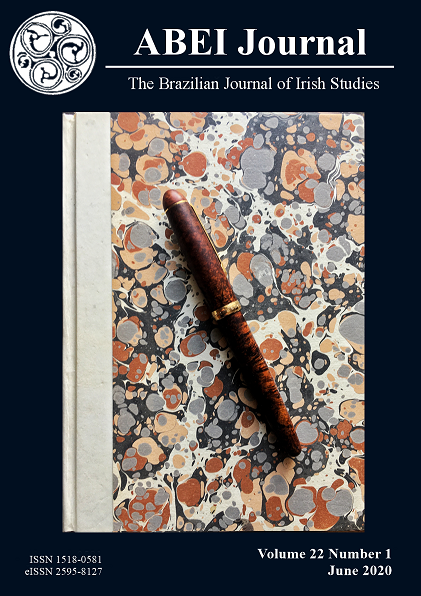Estradas da Fome e Fantasmas da Casa Grande: História e Forma em The Infinities, de John Banville
DOI:
https://doi.org/10.37389/abei.v22i1.3850Palavras-chave:
Gótico, Fome, Casa Grande, John Banville, Emily LawlessResumo
Este artigo considera o envolvimento de John Banville com as memórias da fome irlandesa e as convenções do romance gótico irlandês e sobre a Casa Grande em The Infinities, publicado em 2009, comparando sua abordagem desses tópicos à de Emily Lawless em sua coleção anterior Traits and Confidences de 1897. Argumento que o envolvimento de Banville com a história da fome irlandesa e as convenções do romance gótico irlandês e sobre a Casa Grande não são acidentais à exploração do romance sobre a problemática da identidade e da ideia de si, mas são fundamentais para sua delimitação temática. Além disso, sugiro que a forma experimental do romance se encaixa na tradição literária irlandesa, pois o romance de Banville desenvolve questões de identidade, forma e conteúdo, as quais são centrais ao texto de Lawless.
Referências
Banville, John. Birchwood. Picador, 1973.
---. The Infinites. Picador, 2009.
---. “John Banville, The Art of Fiction No. 200”. Interview by Belinda McKeon. The Paris Review, issue 188, 2009, www.theparisreview.org/interviews/5907/john-banville-the-art-of-fiction-no-200-john-banville. Accessed on 6 January 2017.
---. “The Millions Interview: John Banville.” Interview by Anne K. Yoder. The Millions, themillions.com/2010/02/the-millions-interview-john-banville.html. Accessed 10 December 2019.
Cioséin, Niall O. “Was there ‘Silence’ About the Famine?” Irish Studies Review, vol. 4, no. 13, 1996, pp. 7-10, Taylor and Francis Online. DOI: 10.1080/09670889508455509. Accessed 10 December 2019.
Donnelly Jr., James S. “The Construction of the Memory of the Famine in Ireland and the Irish Diaspora, 1850-1900.” Éire-Ireland, vol. 31, no. 1-2, 1996, pp. 26-61, Project Muse, DOI: 10.1353/eir.1996.0002. Accessed 10 December 2019.
Fegan, Melissa. Literature and the Irish Famine 1845-1919. Oxford University Press, 2002.
Gibbons, Luke. Limits of the Visible: Representing the Great Hunger. Quinnipiac University Press, 2014.
Hand, Derek. John Banville: Exploring Fictions. Liffey Press, 2002.
Haslam, Richard. “Irish Gothic: A Rhetorical Hermeneutics Approach.” Irish Journal of Gothic and Horror Studies no. 2, 2007, pp. 3-26, https://irishgothichorror.files.wordpress.com/2018/03/richard-haslam.pdf. Accessed on 17 December 2019.
Imhof, Rüdiger. John Banville: A Critical Introduction. Wolfhound Press, 1989.
Kelleher, Margaret. The Feminization of Famine: Expressions of the Inexpressible? Cork University Press, 1997.
Kenny, John. John Banville. Irish Academic Press, 2009.
Killeen, Jarlath. The Emergence of Irish Gothic Fiction: History, Origins, Theories. Edinburgh University Press, 2014.
Kinealy, Christine. The Great Irish Famine: Impact, Ideology, and Rebellion. Palgrave MacMillan, 2002.
Kreilkamp, Vera. The Anglo-Irish Novel and the Big House. Syracuse University Press, 1998.
Lawless, Emily. “After the Famine.” Traits and Confidences. Garland Publishing, 1979, pp. 163-217.
---. “Famine Roads and Memory.” Traits and Confidences. Garland Publishing, 1979, pp. 142-62.
Lloyd, David. “The Indigent Sublime: Spectres of Irish Hunger. Irish Times: Temporalities of Modernity. Field Day, 2008. pp. 39-72.
McCormack, W.J. Dissolute Characters: Irish Literary History through Balzac, Sheridan Le Fanu, Yeats, and Bowen. Manchester University Press, 1993.
---. “Irish Gothic and After (1820–1945).” The Field Day Anthology of Irish Writing, Vol. 2, edited by Seamus Deane, Field Day Publications, 1991, 831-949.
Morash, Christopher. “Famine/Holocaust: Fragmented Bodies.” Éire-Ireland, vol. 32, no. 1, 1997, pp. 136-50, Project Muse, DOI: https://doi.org/10.1353/eir.1997.0008. Accessed on 10 December 2019.
Morin, Christina. The Gothic Novel in Ireland: c. 1760-1829. Manchester University Press, 2018.
Moynahan, Julian. Anglo-Irish: The Literary Imagination in a Hyphenated Culture. Princeton University Press, 1995.
Murphy, Neil. John Banville. Bucknell University Press, 2018.
Ó Gráda, Cormac. Black ’47 and Beyond: The Great Irish Famine in History, Economy, and Memory. Princeton University Press, 1999.
O’Malley, Patrick. Catholicism, Sexual Deviance, and Victorian Gothic Culture. Cambridge University Press, 2006.
Schwall, Hedwig. “An Iridescent Surplus of Style: Features of the Fantastic in Banville’s The Infinities.” Nordic Irish Studies, no. 9, 2010, pp. 89-107.
Smart, Robert. Black Roads: The Famine in Irish Literature. Quinnipiac University Press, 2015.
Downloads
Publicado
Edição
Seção
Licença
Copyright (c) 2020 Cody D Jarman

Este trabalho está licenciado sob uma licença Creative Commons Attribution-NonCommercial 4.0 International License.


